by Lisa Cooke | Aug 7, 2015 | 01 What's New, Conferences, Google, images, Technology

Photo courtesy of The Ancestry Insider
New technologies don’t stay new. They keep evolving. Here’s a tip for harnessing new and emerging technologies to advance family history research and stay connected with living relatives.
Last week, I was at the BYU Conference on Family History & Genealogy in Provo, Utah. What a friendly, welcoming group! (Be sure to check out the BYU Family History Library here.) All week, I taught sessions and gave a keynote address on various technologies that help our research. The week’s discussions reminded me how quickly technology moves–and how enthusiastically genealogists continue to embrace new opportunities given them by technology.
It’s part of my job to learn about these new technologies and pass the best ones–the “gems” along to you. But here’s a tip I shared during my keynote address that will help you focus on the technologies you care most about: Think about which tasks you want to accomplish with technology, rather than just learning genealogy-specific technology. Then keep up with developments in the technologies that accomplish those tasks.
For example, by now, many of us have used (or at least heard of) Google Translate. We can use it with foreign-language documents and to correspond with overseas relatives and archives. But Google Translate’s functionality keeps improving. “By the audible gasps of the audience” (during my keynote address) reported the FamilySearch blog, “most were not aware that the Google Translate app enables you to literally hold up your phone to the computer screen or typeset document, and it will translate foreign text on the fly for you—a must have free tool when dabbling in nonnative language content.”
Genealogists are really thinking about these issues. The Ancestry Insider blogged about my keynote talk, too, and my observation that genealogists haven’t been embracing digital video at the same speed at which they embrace other forms of digital media. In the comments section of that post Cathy added, “Now what we need to do is get FamilySearch to figure out a way to let us upload our URL YOUTube videos, not only for our deceased, but for our living….Our children and grandchildren don’t write letters, they email, text, instagram. They don’t write journals, they blog. They make videos of current history….We all need to look to the future and [learn] how to save the new technologies.” Cathy gets it!
A special thanks to conference organizers Stephen Young and John Best, who welcomed me and Genealogy Gems Contributing Editor Sunny Morton all week long. They did a fantastic job of organizing a large event while retaining a warm, personal environment.
Continue reading about applying technology to your family history here.
by Lisa Cooke | Jan 22, 2016 | 01 What's New, Records & databases
Here’s our weekly roundup of cool new genealogy records online. Should you search any of these: an 1831 England census substitute; parish records for Hertfordshire; images of French forts in North America; Michigan death records; outgoing passenger lists for the US and War of 1812 pension records?
ENGLAND 1831 CENSUS SUBSTITUTE. There’s a new 1831 census substitute database at Findmypast! England, Pollbooks and Directories 1830-1837 allows you to discover where your ancestors lived, how they earned a living and how they voted. This collection of assorted documents also plugs the important gap left by the lack of a complete 1831 census.”
ENGLAND PARISH REGISTERS. Findmypast now has a browsable collection of parish records for Hertfordshire. The collection spans 1538-1988: that’s 450 years and 1.9 million pages of baptisms, marriages and burials.
NEW FRANCE. Library & Archives Canada has published a new Flickr photo collection with images of North American forts built or captured by the French during the era of New France. It’s free to explore and the history is fascinating!
MICHIGAN DEATHS. A new collection of Michigan Death Records, 1857-1960 is available to Ancestry.com subscribers. Death registers and certificates contain varying amounts of genealogical information.
US TRAVELERS ABROAD. Ancestry.com has a new database of departing passengers and crew from various U.S. locations (1916-1962) by ship and air. These include military transports. “Details requested on the forms varied, but they typically include the name of the vessel, departure date, ports of departure and destination, shipmaster, full name, age, gender, physical description, military rank (if any), occupation, birthplace, citizen of what country, and residence.” Later documents may include visa or passport information.
WAR OF 1812 PENSIONS (US). Images of pension records for US soldiers with surnames beginning A-M have been posted on Fold3, where they are available to view for FREE. This is part of the ongoing Preserve the Pensions project led by the Federation of Genealogical Societies. Click here to learn more and contribute to funding for this crowd-sourced effort.
 Looking for a specific type of record about your ancestor? Want to find more new genealogy records online yourself? Click here for step-by-step instructions on using Google to search for specific records.
Looking for a specific type of record about your ancestor? Want to find more new genealogy records online yourself? Click here for step-by-step instructions on using Google to search for specific records.
by Lacey Cooke | Sep 26, 2018 | 01 What's New
In the new Genealogy Gems Premium Podcast Episode 163, you’ll hear what’s happening with a trove of 160,000 pieces of undelivered mail dating back to the 1600s, an adoptee’s personal response to Premium Episode 162, and tips on finding U.S. Navy photos....
by Lisa Cooke | Jul 10, 2017 | 01 What's New, Archive Lady, Preservation
Jennifer recently wrote in with a question about how to archive family history documents, and I knew just who to turn to: The Archive Lady! Melissa Barker is joining the Genealogy Gems Podcast and blog to help answer your questions about your precious possessions.

Let’s get right to Jennifer’s question:
Lisa,
I recently received my grandfather’s birth certificate from my cousin. My family knows that I am researching our family tree and are not surprised when I ask them for information or to take a picture of family gatherings and send it to me. Most of my mother’s side of the family live in Wisconsin and I am in New Hampshire, so I don’t get to visit with them often. The birth certificate is very old and fragile and I’m wondering how do I store it so it will be around for future generations.
Thank you for any ideas.
Jennifer
It’s fabulous to find genealogical documents online, but there’s nothing like touching and possessing the original. I reached out to our Archive Lady here at Genealogy Gems, Melissa Barker to get her advice on archiving family history documents.
(Full disclosure: the links below are affiliate links that will take you to the products Melissa’s recommends in Amazon. While there’s no additional cost to you, we will be compensated for the referral. Thank you for helping us keep this blog and the Genealogy Gems Podcast free!)
How to Archive Family History Documents from the Archive Lady
“Jennifer, what a wonderful treasure to receive, your grandfather’s birth certificate. Preserving original records such as birth certificates is so very important for future generations.
First, I would suggest that you scan the certificate or take a photograph of it so that it is preserved digitally. Then the certificate needs to be encapsulated in an archival sleeve. Usually these sleeves are made from Mylar, Polypropylene or Polyester and can be bought at any online archival store. These sleeves can be top loading or they can be open on two sides, which are called L-sleeves. Place the certificate in the sleeve for the first layer of protection.
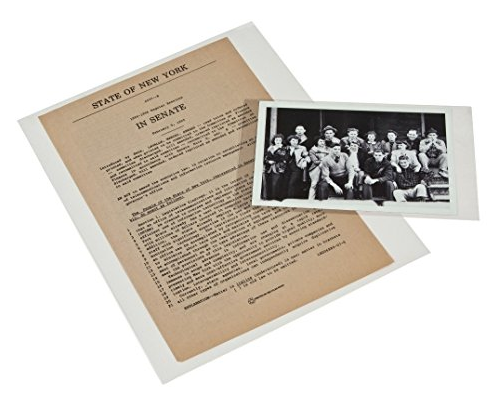 Then I suggest that you place the encapsulated certificate in an archival file folder and place in an archival Hollinger box. This will give you 3-layers of archival protection for your certificate.
Then I suggest that you place the encapsulated certificate in an archival file folder and place in an archival Hollinger box. This will give you 3-layers of archival protection for your certificate.
Store all documents and photographs in a cool, dark and dry place.
Following these easy steps will ensure that your grandfather’s birth certificate will be enjoyed for generations to come!”
.
More Resources for How to Archive Your Family History
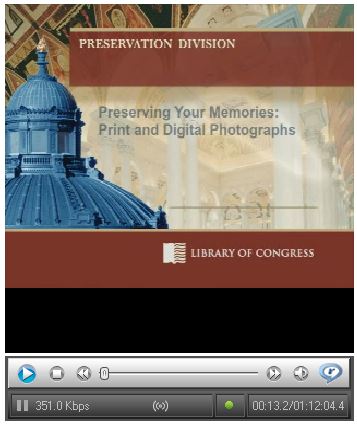 Thank you to Melissa for helping Jennifer and all our readers understand how to archive family history documents in proper way. The Library of Congress has a FREE video about how to create and properly preserve digital or print archival scrapbooks.
Thank you to Melissa for helping Jennifer and all our readers understand how to archive family history documents in proper way. The Library of Congress has a FREE video about how to create and properly preserve digital or print archival scrapbooks.
It’s a 72-minute video by various experts with a downloadable transcript on these topics:
- Basic preservation measures one can do at home for long-lasting albums and scrapbooks
- Pros and cons of dismantling old scrapbooks and albums in poor condition
- How to address condition problems
- Preservation considerations for digital scrapbooks and albums
- How to participate in the Library’s Veterans History Project.
And here on the Genealogy Gems blog we have an article for you about understanding the impact that humidity can have you on your family history collection. Click here to read Humidity and Your Family Archive: Why It Matters.
by Lisa Cooke | Apr 9, 2018 | 01 What's New, Listeners & Readers, Maps
You can now see New York City street views from the late 1800s and early 1900s as Google Earth street views. Take a virtual visit to the Big Apple as it was 100 years ago! Or travel back even further in time to an 1836 map of NYC conveniently overlaid on a modern Google Earth view. These are just two of the many ways to use Google Earth for genealogy—and for fun.
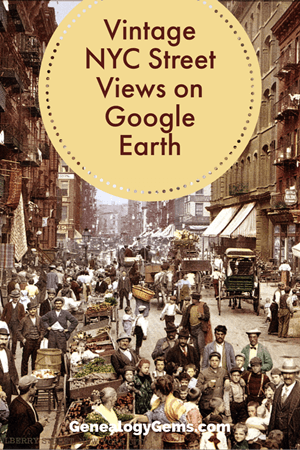
Vintage New York City Street Views on Google Earth
Over 80,000 original photos from the late 1800s and early 1900s have been mapped into Google Earth to provide what’s essentially a Google Street View map of old New York City!
The site is called OldNYC, and it’s free.
As you can see from this overview map (below), the old photos are concentrated in the areas of Staten Island, Brooklyn, Queens and Lower and Upper Manhattan. Dots represents historic photos that have been overlaid on Google Earth’s modern map (satellite view is also available).
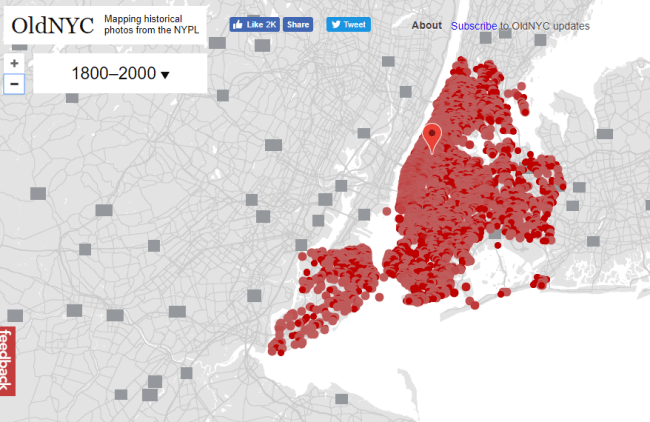
Old NYC
You can zoom in to click on individual dots, which will bring up one or more individual photos of certain neighborhoods or street fronts:
Select the photos that match up best with your family history interests, such as a shot of your family’s old store front or apartment building. Or choose images that represent the time period in which your relatives lived in the area, so you can get a flavor of what their neighborhood would have looked like. (Click here for some ideas about where to look for your family’s exact address during the late 1800s or early 1900s.)
These photos all come from the New York Public Library’s Photographic Views of New York City, 1870s-1970s collection, which is also free to view online.
According to this article at BusinessInsider.com, a developer Dan Vanderkam worked with the New York Public Library to plot all the photos onto Google Earth. (A hat-tip to Genealogy Gems listener and reader Jennifer, who sent me this article because she knows how much I love old maps and data visualization!)
Another Old NYC Street View: 1836 Map
While we’re on the subject, I also want to mention another cool tool for visualizing old NYC street views. At the Smithsonian.com, there’s a cool historic map overlay of an 1836 New York City map in Google Earth. Use the scrolling and zooming tools to explore the parts of NYC that were already settled–and to compare them to what’s there today. You can also swap views to see the 1836 map with just a little round window of the modern streets.
The accompanying article quotes famous map collector David Rumsey about the 1836 map, which is his. He describes how you can see that much of the topography of Manhattan has changed over the years—did you know Manhattan used to be hilly? And I love how he calls out artistic features on the old map, too.
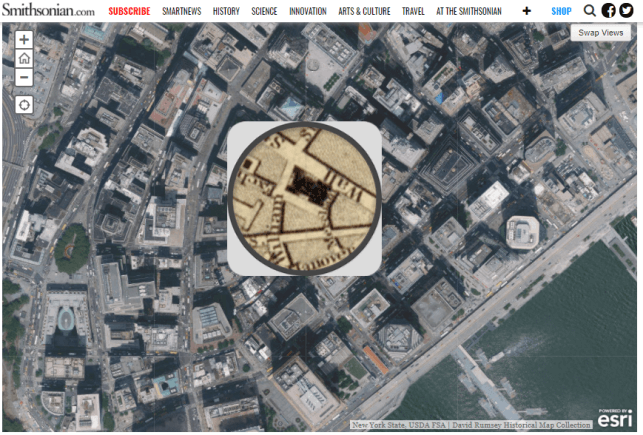
Smithsonian NYC street view 1836
Unfortunately, the old map doesn’t show much in the way of residents’ property lines or buildings. But you can clearly see the street layouts and where the parks and hills were. Comparing these areas with Google Earth’s street view today can help you better understand what things looked like in a much older version of one of the world’s great cities.
Use Google Earth for Your Genealogy
There are so many ways to use Google Earth for genealogy! My free video class will get you started. After a quick tutorial on downloading and navigating Google Earth, see how to utilize its powerful tools to identify an old family photo, map out addresses that may have changed and even plot an old ancestral homestead.
Click here to enjoy this free video!
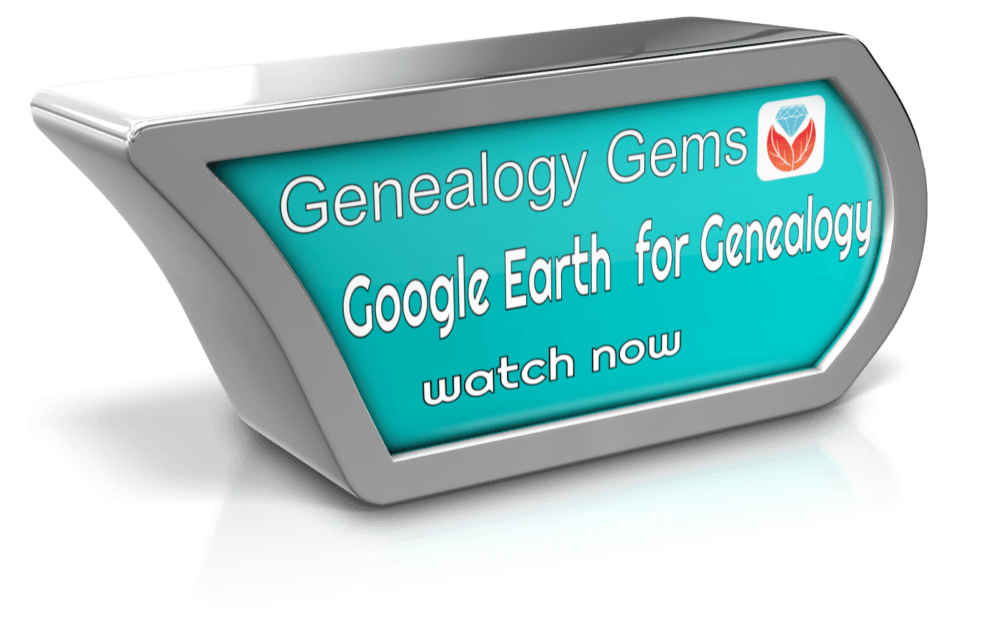




 Then I suggest that you place the encapsulated certificate in an archival file folder and place in an archival
Then I suggest that you place the encapsulated certificate in an archival file folder and place in an archival  Thank you to Melissa for helping Jennifer and all our readers understand how to archive family history documents in proper way. The Library of Congress has a
Thank you to Melissa for helping Jennifer and all our readers understand how to archive family history documents in proper way. The Library of Congress has a 


